Applied Mathematics and Mechanics (English Edition) ›› 2025, Vol. 46 ›› Issue (8): 1451-1474.doi: https://doi.org/10.1007/s10483-025-3285-8
Previous Articles Next Articles
N. A. SAEED1,2,3, Y. Y. ELLABBAN4, Lei HOU2,†( ), Haiming YI2, Shun ZHONG5, F. Z. DURAIHEM6, O. M. OMARA1
), Haiming YI2, Shun ZHONG5, F. Z. DURAIHEM6, O. M. OMARA1
Received:2025-04-10
Revised:2025-06-23
Published:2025-07-28
Contact:
Lei HOU, E-mail: houlei@hit.edu.cnSupported by:2010 MSC Number:
N. A. SAEED, Y. Y. ELLABBAN, Lei HOU, Haiming YI, Shun ZHONG, F. Z. DURAIHEM, O. M. OMARA. Nonlinear vibration of quasi-zero stiffness structure with piezoelectric harvester and RL-load: intra-well and inter-well oscillation modes under 1:1 internal resonance. Applied Mathematics and Mechanics (English Edition), 2025, 46(8): 1451-1474.
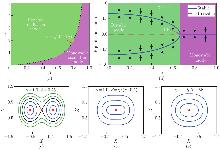
Fig. 2
(a) Bistable and monostable boundaries of considered quasi-zero mechanical oscillator in βγ-space. (b) Equilibrium point bifurcation of autonomous unperturbed oscillator. Phase space scenarios of autonomous unperturbed oscillator at different values of β when γ=1.0: (c) bistable oscillation scenario; (d) critical oscillation scenario; (e) monostable oscillation scenario (color online)"

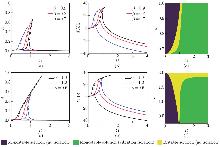
Fig. 6
Influence of β and γ and dynamical behaviors of QZS system for F=0.015: (a) oscillation amplitude and (b) corresponding displacement transmissibility for γ=1.0; (c) vibration isolation region in Ωβ-space for γ=1.0; (d) oscillation amplitude and (e) corresponding displacement transmissibility for β=0.8; (f) vibration isolation region in Ωγ-space for β=0.8 (color online)"


Fig. 17
Time-response curves of oscillator-harvester system corresponding to Fig. 16 for F=0.025 and Ω=0.5: (a)–(b) intra-well and inter-well oscillation modes of mechanical oscillator, depending on initial conditions; (c)–(d) corresponding low- and high-amplitude harvested voltage (color online)"
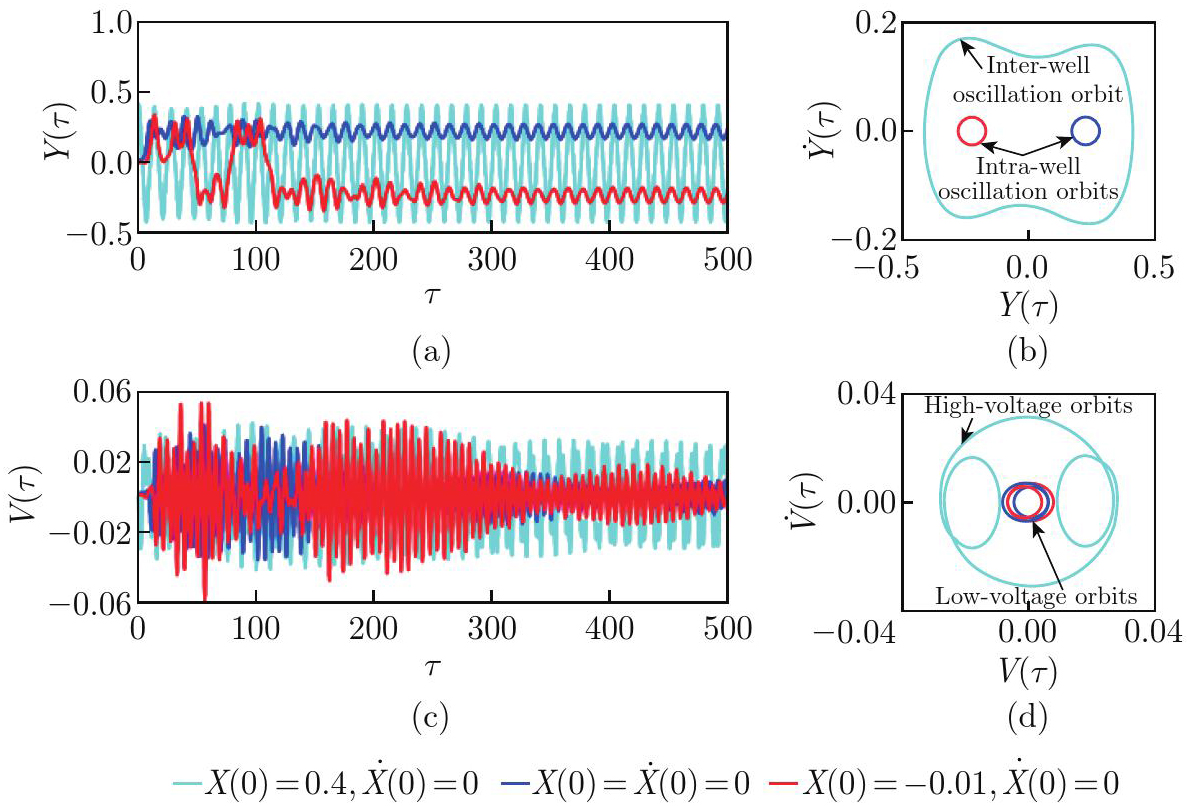

Fig. 22
Bifurcation diagrams and steady-sate phase plane trajectories of oscillator-harvester system corresponding to Fig. 21 for Ω=1.25: (a) bifurcation diagram; (b)–(c) chaotic responses of oscillator-harvester system for Ω=1.25. Legends of (b) and (c) are as follows. Red lines: F=0.050; green lines: F=0.075; blue lines: F=0.100; purple lines: F=0.125; black lines: F=0.150 (color online)"
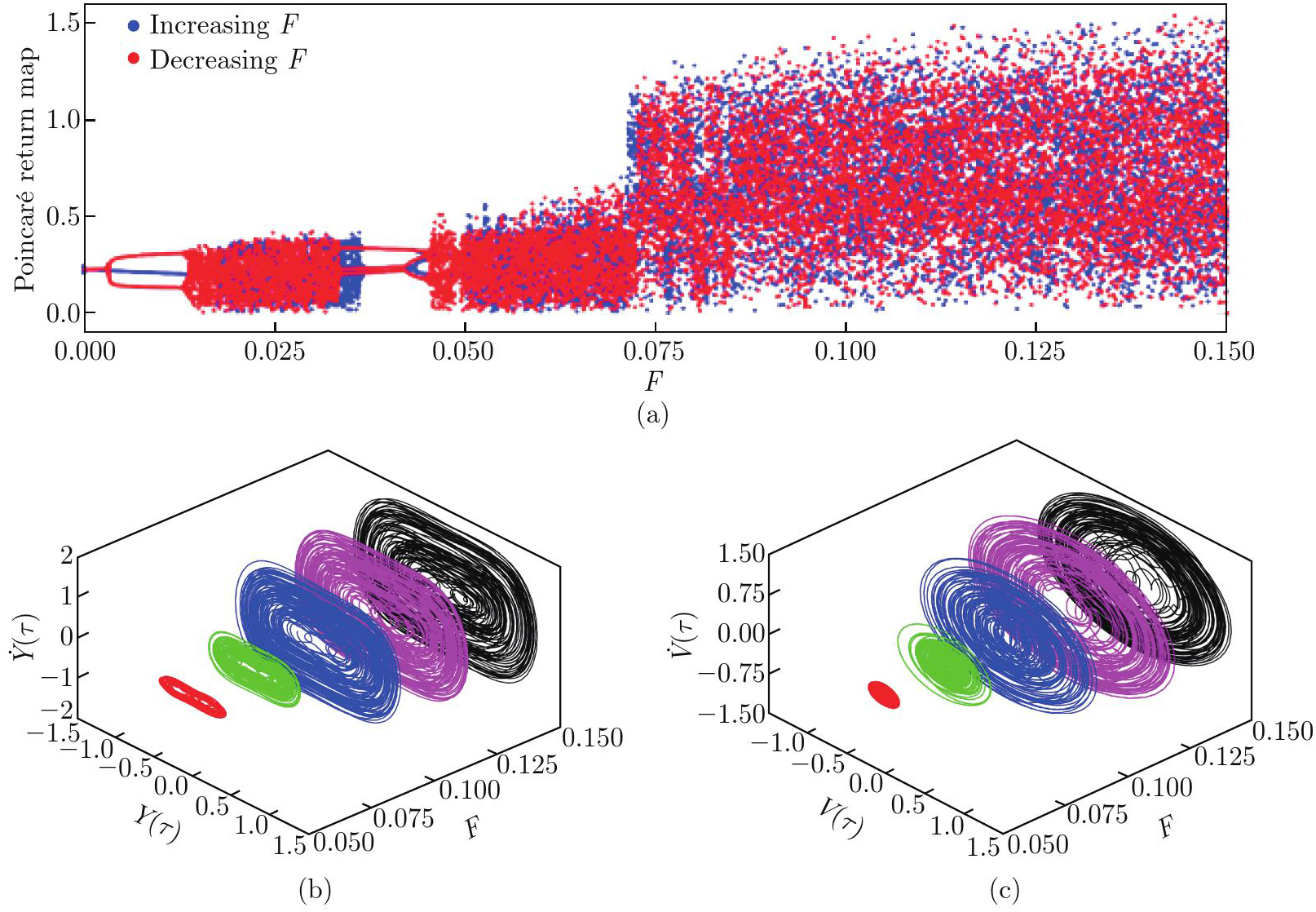
| [1] | IBRAHIM, R. Recent advances in nonlinear passive vibration isolators. Journal of Sound and Vibration, 314(3-5), 371–452 (2008) |
| [2] | LIU, C., JING, X., DALEY, S., and LI, F. Recent advances in micro-vibration isolation. Mechanical Systems and Signal Processing, 56-57, 55–80 (2015) |
| [3] | ZENG, R., WEN, G., ZHOU, J., YIN, S., WANG, Q., and WU, X. Experimental investigation of a non-smooth quasi-zero-stiffness isolator. Acta Mechanica Sinica, 39(6), 522415 (2023) |
| [4] | LING, P., MIAO, L., YE, B., YOU, J., ZHANG, W., and YAN, B. Ultra-low frequency vibration isolation of a novel click-beetle-inspired structure with large quasi-zero stiffness region. Journal of Sound and Vibration, 558, 117756 (2023) |
| [5] | LIU, C., ZHANG, W., YU, K., LIU, T., and ZHENG, Y. Quasi-zero-stiffness vibration isolation: designs, improvements and applications. Engineering Structures, 301, 117282 (2024) |
| [6] | WANG, K., ZHOU, J., TAN, D., LI, Z., LIN, Q., and XU, D. A brief review of metamaterials for opening low-frequency band gaps. Applied Mathematics and Mechanics (English Edition), 43(7), 1125–1144 (2022) https://doi.org/10.1007/s10483-022-2870-9 |
| [7] | SAEED, N. A. and EISSA, M. Bifurcation analysis of a transversely cracked nonlinear Jeffcott rotor system at different resonance cases. International Journal of Acoustics and Vibration, 24(2), 284–302 (2019) |
| [8] | SAEED, N. A., MOATIMID, G. M., ELSABAA, F. M. F., and ELLABBAN, Y. Y. Time-delayed control to suppress a nonlinear system vibration utilizing the multiple scales homotopy approach. Archive of Applied Mechanics, 91, 1193–1215 (2021) |
| [9] | EISSA, M., KAMEL, M., SAEED, N. A., EL-GANAINI, W., and EL-GOHARY, H. Time-delayed positive-position and velocity feedback controller to suppress the lateral vibrations in nonlinear Jeffcott-rotor system. Menoufia Journal of Electronic Engineering Research, 27, 261–278 (2018) |
| [10] | SAEED, N. A., MOHAMED, M. S., ELAGAN, S. K., and AWREJCEWICZ, J. Integral resonant controller to suppress the nonlinear oscillations of a two-degree-of-freedom rotor active magnetic bearing system. Processes, 10, 271 (2022) |
| [11] | SAEED, N. A., MOATIMID, G. M., ELSABAA, F. M., ELLABBAN, Y. Y., ELAGAN, S. K., and MOHAMED, M. S. Time-delayed nonlinear integral resonant controller to eliminate the nonlinear oscillations of a parametrically excited system. IEEE Access, 9, 74836–74854 (2021) |
| [12] | EL-SHOURBAGY, S. M., SAEED, N. A., KAMEL, M., RASLAN, K. R., ABOUEL NASR, E., and AWREJCEWICZ, J. On the performance of a nonlinear position-velocity controller to stabilize rotor-active magnetic-bearings system. Symmetry, 13, 2069 (2021) |
| [13] | SAEED, N. A., EL-BENDARY, S., SAYED, M., MOHAMED, M., and ELAGAN, S. On the oscillatory behaviours and rub-impact forces of a horizontally supported asymmetric rotor system under position-velocity feedback controller. Latin American Journal of Solids and Structures, 18(2), e349 (2021) |
| [14] | SAEED, N. A., AWREJCEWICZ, J., HAFEZ, S. T., HOU, L., and ABOUDAIF, M. K. Stability, bifurcation, and vibration control of a discontinuous nonlinear rotor model under rub-impact effect. Nonlinear Dynamics, 111, 20661–20697 (2023) |
| [15] | ERTURK, A. and INMAN, D. J. Piezoelectric Energy Harvesting, John Wiley & Sons, Hoboken (2011) |
| [16] | OTTMAN, G., HOFMANN, H., BHATT, A., and LESIEUTRE, G. Adaptive piezoelectric energy harvesting circuit for wireless, remote power supply. IEEE Transactions on Power Electronics, 17(5), 669–676 (2002) |
| [17] | COOK-CHENNAULT, K. A., THAMBI, N., and SASTRY, A. M. Powering MEMS portable devices — a review of non-regenerative and regenerative power supply systems with special emphasis on piezoelectric energy harvesting systems. Smart Materials and Structures, 17(4), 043001 (2008) |
| [18] | ABDELKAREEM, M. A. A., XU, L., ALI, M. K. A., ELAGOUZ, A., MI, J., GUO, S., LIU, Y., and ZUO, L. Vibration energy harvesting in automotive suspension system: a detailed review. Applied Energy, 229, 672–699 (2018) |
| [19] | PUTRA, T., HUSAINI, and IKBAL, M. Automotive suspension component behaviors driven on flat and rough road surfaces. Heliyon, 7(7), e07528 (2021) |
| [20] | ZHOU, S., SONG, G., WANG, R., REN, Z., and WEN, B. Nonlinear dynamic analysis for coupled vehicle-bridge vibration system on nonlinear foundation. Mechanical Systems and Signal Processing, 87, 259–278 (2017) |
| [21] | ZUO, J., DONG, L., YANG, F., GUO, Z., WANG, T., and ZUO, L. Energy harvesting solutions for railway transportation: a comprehensive review. Renewable Energy, 202, 56–87 (2023) |
| [22] | GHOLIKHANI, M., ROSHANI, H., DESSOUKY, S., and PAPAGIANNAKIS, A. T. A critical review of roadway energy harvesting technologies. Applied Energy, 261, 114388 (2020) |
| [23] | LEI, S., GE, Y., LI, Q., and THOMPSON, D. J. Frequency-domain method for non-stationary stochastic vibrations of train-bridge coupled system with time-varying characteristics. Mechanical Systems and Signal Processing, 183, 109637 (2023) |
| [24] | CAHILL, P., HAZRA, B., KAROUMI, R., MATHEWSON, A., and PAKRASHI, V. Vibration energy harvesting-based monitoring of an operational bridge undergoing forced vibration and train passage. Mechanical Systems and Signal Processing, 106, 265–283 (2018) |
| [25] | YANG, K., ABDELKEFI, A., LI, X., MAO, Y., DAI, L., and WANG, J. Stochastic analysis of a galloping-random wind energy harvesting performance on a buoy platform. Energy Conversion and Management, 238, 114174 (2021) |
| [26] | BAO, B., ZHOU, S., and WANG, Q. Interplay between internal resonance and nonlinear magnetic interaction for multi-directional energy harvesting. Energy Conversion and Management, 244, 114465 (2021) |
| [27] | ABOHAMER, M. K., AWREJCEWICZ, J., STAROSTA, R., AMER, T. S., and BEK, M. A. Influence of the motion of a spring pendulum on energy-harvesting devices. Applied Sciences, 11(18), 8658 (2021) |
| [28] | AMER, T. S., WAHBA, A. M., ABOLILA, A. F., and GALAL, A. A. Optimizing stability and characteristics of a vibrating rigid body pendulum with energy harvesting device. Journal of Low Frequency Noise, Vibration and Active Control, 44(2), 893–937 (2025) |
| [29] | ABOHAMER, M. K., AWREJCEWICZ, J., and AMER, T. S. Modeling of the vibration and stability of a dynamical system coupled with an energy harvesting device. Alexandria Engineering Journal, 63, 377–397 (2023) |
| [30] | GU, Y., LIU, W., ZHAO, C., and WANG, P. A goblet-like non-linear electromagnetic generator for planar multi-directional vibration energy harvesting. Applied Energy, 266, 114846 (2020) |
| [31] | ZHAO, L., ZOU, H., ZHAO, Y., WU, Z., LIU, F., WEI, K., and ZHANG, W. Hybrid energy harvesting for self-powered rotor condition monitoring using maximal utilization strategy in structural space and operation process. Applied Energy, 314, 118983 (2022) |
| [32] | LAI, Z., WANG, S., ZHU, L., ZHANG, G., WANG, J., YANG, K., and YURCHENKO, D. A hybrid piezo-dielectric wind energy harvester for high-performance vortex-induced vibration energy harvesting. Mechanical Systems and Signal Processing, 150, 107212 (2021) |
| [33] | SUN, W., JIANG, Z., XU, X., HAN, Q., and CHU, F. Harmonic balance analysis of output characteristics of free-standing mode triboelectric nanogenerators. International Journal of Mechanical Sciences, 207, 106668 (2021) |
| [34] | ZOU, H., ZHAO, L., WANG, Q., GAO, Q., YAN, G., WEI, K., and ZHANG, W. A self-regulation strategy for triboelectric nanogenerator and self-powered wind-speed sensor. Nano Energy, 95, 106990 (2022) |
| [35] | AMER, T. S., ARAB, A., and GALAL, A. A. On the influence of an energy harvesting device on a dynamical system. Journal of Low Frequency Noise, Vibration and Active Control, 43(2), 669–705 (2024) |
| [36] | AMER, T. S., ABDELHFEEZ, S. A., ELBAZ, R. F., and ABOHAMER, M. K. Investigation of the dynamical analysis, stability, and bifurcation for a connected damped oscillator with a piezoelectric harvester. Journal of Vibration Engineering & Technologies, 13, 155 (2025) |
| [37] | FANG, S., ZHOU, S., YURCHENKO, D., YANG, T., and LIAO, W. H. Multistability phenomenon in signal processing, energy harvesting, composite structures, and metamaterials: a review. Mechanical Systems and Signal Processing, 166, 108419 (2022) |
| [38] | CHEN, K., DING, X., TIAN, L., SHEN, H., SONG, R., BIAN, Y., and YANG, Q. An M-shaped buckled beam for enhancing nonlinear energy harvesting. Mechanical Systems and Signal Processing, 188, 110066 (2023) |
| [39] | LAN, C., LIAO, Y., HU, G., and TANG, L. Equivalent impedance and power analysis of monostable piezoelectric energy harvesters. Journal of Intelligent Material Systems and Structures, 31(14), 1697–1715 (2020) |
| [40] | DULIN, S., LIN, K., SERDUKOVA, L., KUSKE, R., and YURCHENKO, D. Improving the performance of a two-sided vibro-impact energy harvester with asymmetric restitution coefficients. International Journal of Mechanical Sciences, 217, 106983 (2022) |
| [41] | FAN, K., LIU, J., WEI, D., ZHANG, D., ZHANG, Y., and TAO, K. A cantilever-plucked and vibration-driven rotational energy harvester with high electric outputs. Energy Conversion and Management, 244, 114504 (2021) |
| [42] | TANG, L., YANG, Y., and SOH, C. K. Toward broadband vibration-based energy harvesting. Journal of Intelligent Material Systems and Structures, 21(18), 1867–1897 (2010) |
| [43] | CAO, D., WANG, J., GUO, X., LAI, S., and SHEN, Y. Recent advancement of flow-induced piezoelectric vibration energy harvesting techniques: principles, structures, and nonlinear designs. Applied Mathematics and Mechanics (English Edition), 43(7), 959–978 (2022) https://doi.org/10.1007/s10483-022-2867-7 |
| [44] | ZHOU, S., CAO, J., and LIN, J. Theoretical analysis and experimental verification for improving energy harvesting performance of nonlinear monostable energy harvesters. Nonlinear Dynamics, 86(3), 1599–1611 (2016) |
| [45] | FAN, K., TAN, Q., LIU, H., ZHANG, Y., and CAI, M. Improved energy harvesting from low-frequency small vibrations through a monostable piezoelectric energy harvester. Mechanical Systems and Signal Processing, 117, 594–608 (2019) |
| [46] | KUMAR, A., ALI, S. F., and AROCKIARAJAN, A. Exploring the benefits of an asymmetric monostable potential function in broadband vibration energy harvesting. Applied Physics Letters, 112(23), 233901 (2018) |
| [47] | REZAEI, M., TALEBITOOTI, R., LIAO, W. H., and FRISWELL, M. I. Integrating PZT layer with tuned mass damper for simultaneous vibration suppression and energy harvesting considering exciter dynamics: an analytical and experimental study. Journal of Sound and Vibration, 546, 117413 (2023) |
| [48] | LI, X., LIU, K., XIONG, L., and TANG, L. Development and validation of a piecewise linear nonlinear energy sink for vibration suppression and energy harvesting. Journal of Sound and Vibration, 503, 116104 (2021) |
| [49] | LU, Z., ZHAO, L., DING, H., and CHEN, L. A dual-functional metamaterial for integrated vibration isolation and energy harvesting. Journal of Sound and Vibration, 509, 116251 (2021) |
| [50] | BUKHARI, M. and BARRY, O. Simultaneous energy harvesting and vibration control in a nonlinear metastructure: a spectro-spatial analysis. Journal of Sound and Vibration, 473, 115215 (2020) |
| [51] | FANG, S., CHEN, K., ZHAO, B., LAI, Z., ZHOU, S., and LIAO, W. H. Simultaneous broadband vibration isolation and energy harvesting at low frequencies with quasi-zero stiffness and nonlinear monostability. Journal of Sound and Vibration, 553, 117684 (2023) |
| [52] | LI, Y., BAKER, E., REISSMAN, T., SUN, C., and LIU, W. K. Design of mechanical metamaterials for simultaneous vibration isolation and energy harvesting. Applied Physics Letters, 111(25), 251903 (2017) |
| [53] | LIU, C., ZHAO, R., YU, K., LEE, H. P., and LIAO, B. Simultaneous energy harvesting and vibration isolation via quasi-zero-stiffness support and radially distributed piezoelectric cantilever beams. Applied Mathematical Modelling, 100, 152–169 (2021) |
| [54] | SAEED, N. A., ELLABBAN, Y. Y., MOATIMID, G. M., HOU, L., and MOHAMED, A. F. Nonlinear interactions of an n-layer X-shape low-frequency vibration isolator equipped with a nonlinear vibration absorber at 1:1 internal resonance: analytical and numerical investigations. Physica Scripta, 99(10), 105207 (2024) |
| [55] | SAEED, N. A., ELLABBAN, Y. Y., HOU, L., MOATIMID, G. M., ZHONG, S., and DURAIHEM, F. Z. Nonlinear dynamics of a bio-inspired 2-DOF low-frequency X-shaped vibration isolator with m-to-n layers driven harmonically under simultaneous primary and 1:1 internal resonances. Chaos, Solitons & Fractals, 190, 115786 (2025) |
| [56] | SHAHRAEENI, M., SOROKIN, V., MACE, B., and ILANKO, S. Effect of damping nonlinearity on the dynamics and performance of a quasi-zero-stiffness vibration isolator. Journal of Sound and Vibration, 526, 116822 (2022) |
| [57] | SAEED, N. A., AWREJCEWICZ, J., ALKASHIF, M. A., and MOHAMED, M. S. 2D and 3D visualization for the static bifurcations and nonlinear oscillations of a self-excited system with time-delayed controller. Symmetry, 14, 621 (2022) |
| [58] | SUN, K. H., LIU, X., and ZHU, C. X. The 0-1 test algorithm for chaos and its applications. Chinese Physics B, 19, 110510 (2010) |
| [1] | Tingting CHEN, Kai WANG, Shengchao CHEN, Ziyu XU, Zhe LI, Jiaxi ZHOU. Nonlinear electromechanical coupling dynamics of a two-degree-of-freedom hybrid energy harvester [J]. Applied Mathematics and Mechanics (English Edition), 2025, 46(6): 989-1010. |
| [2] | Tianchi YU, Feng LIANG, Hualin YANG. Vibration energy harvesting of a three-directional functionally graded pipe conveying fluids [J]. Applied Mathematics and Mechanics (English Edition), 2025, 46(5): 795-812. |
| [3] | Zhouchao WEI, Yuxi LI, T. KAPITANIAK, Wei ZHANG. Chaotic characteristics for a class of hydro-pneumatic near-zero frequency vibration isolators under dry friction and noise excitation [J]. Applied Mathematics and Mechanics (English Edition), 2025, 46(4): 647-662. |
| [4] | Jiamei WANG, Siukai LAI, Chen WANG, Yiting ZHANG, Zhaolin CHEN. On the role of sliding friction effect in nonlinear tri-hybrid vibration-based energy harvesting [J]. Applied Mathematics and Mechanics (English Edition), 2024, 45(8): 1295-1314. |
| [5] | Xinyu LIAN, Bing LIU, Huaxia DENG, Xinglong GONG. A vibration isolator with a controllable quasi-zero stiffness region based on nonlinear force design [J]. Applied Mathematics and Mechanics (English Edition), 2024, 45(8): 1279-1294. |
| [6] | Long ZHAO, Zeqi LU, Hu DING, Liqun CHEN. A viscoelastic metamaterial beam for integrated vibration isolation and energy harvesting [J]. Applied Mathematics and Mechanics (English Edition), 2024, 45(7): 1243-1260. |
| [7] | Kefan XU, Muqing NIU, Yewei ZHANG, Liqun CHEN. An active high-static-low-dynamic-stiffness vibration isolator with adjustable buckling beams: theory and experiment [J]. Applied Mathematics and Mechanics (English Edition), 2024, 45(3): 425-440. |
| [8] | Lanbin ZHANG, Yixiang HE, Bo MENG, Huliang DAI, Lin WANG. Unlocking multidirectional and broadband wind energy harvesting with triboelectric nanogenerator and vortex-induced vibration of sphere [J]. Applied Mathematics and Mechanics (English Edition), 2024, 45(11): 1895-1912. |
| [9] | Yang JIN, Tianzhi YANG. Enhanced vibration suppression and energy harvesting in fluid-conveying pipes [J]. Applied Mathematics and Mechanics (English Edition), 2023, 44(9): 1487-1496. |
| [10] | Guangdong SUI, Shuai HOU, Xiaofan ZHANG, Xiaobiao SHAN, Chengwei HOU, Henan SONG, Weijie HOU, Jianming LI. A bio-inspired spider-like structure isolator for low-frequency vibration [J]. Applied Mathematics and Mechanics (English Edition), 2023, 44(8): 1263-1286. |
| [11] | Jihou YANG, Weixing ZHANG, Xiaodong YANG. Integrated device for multiscale series vibration reduction and energy harvesting [J]. Applied Mathematics and Mechanics (English Edition), 2023, 44(12): 2227-2242. |
| [12] | Bin ZHANG, Hongsheng LIU, Shengxi ZHOU, Jun GAO. A review of nonlinear piezoelectric energy harvesting interface circuits in discrete components [J]. Applied Mathematics and Mechanics (English Edition), 2022, 43(7): 1001-1026. |
| [13] | Dongxing CAO, Junru WANG, Xiangying GUO, S. K. LAI, Yongjun SHEN. Recent advancement of flow-induced piezoelectric vibration energy harvesting techniques: principles, structures, and nonlinear designs [J]. Applied Mathematics and Mechanics (English Edition), 2022, 43(7): 959-978. |
| [14] | Qiong WANG, Zewen CHEN, Linchuan ZHAO, Meng LI, Hongxiang ZOU, Kexiang WEI, Xizheng ZHANG, Wenming ZHANG. Enhanced galloping energy harvester with cooperative mode of vibration and collision [J]. Applied Mathematics and Mechanics (English Edition), 2022, 43(7): 945-958. |
| [15] | Guoxin JIN, Zhenghao WANG, Tianzhi YANG. Cascaded quasi-zero stiffness nonlinear low-frequency vibration isolator inspired by human spine [J]. Applied Mathematics and Mechanics (English Edition), 2022, 43(6): 813-824. |
| Viewed | ||||||
|
Full text |
|
|||||
|
Abstract |
|
|||||

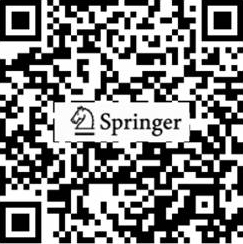
 Email Alert
Email Alert RSS
RSS